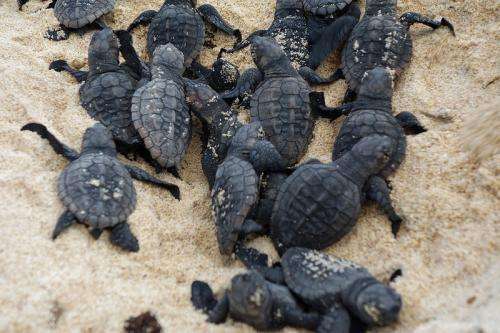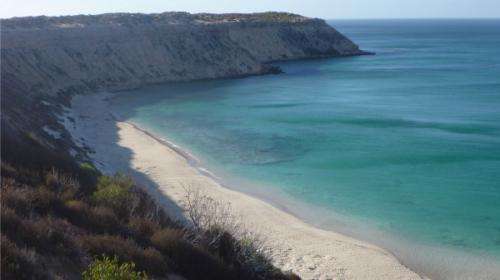Turtle embryos genetically wired for hotter summers

Endangered loggerhead turtles (Caretta caretta) are able to protect themselves against environmental temperature fluctuations while still in the egg, a UWA researcher has discovered.
A study by School of Animal Biology and Oceans Institute researcher Jamie Tedeschi found embryonic loggerhead turtles increased their expression of heat-protective genes when exposed to bursts of higher temperature.
"Loggerhead turtle eggs develop best between 25 and 33 degrees [Celsius]," Ms Tedeschi says.
"But we are seeing some beaches in the Gascoyne region getting really hot early in summer, and they are staying hot for longer."
"Since [the embryos] can't behaviourally move into shade or cooler water, like adults would be able to, I assumed that there would be some physiological mechanism that would help them cope with these temperatures," she says.
And as Ms Tedeschi's research shows, there is.
The study provides the first evidence of a response at the molecular level to heat stress in reptiles.
Ms Tedeschi and her team collected 384 newly-laid eggs from four nesting sites in Turtle Bay, on Dirk Hartog Island, the southernmost loggerhead turtle rookery in the world, and also one of the largest.
The eggs were divided into test batches and kept in incubation chambers to continue their development.
At days 25 or 45, the eggs were heat-shocked at temperatures of 29, 34 or 36 degrees Celsius for one or three hours.

These temperatures and times were chosen to mimic observed environmental conditions on known turtle nesting beaches.
The temperatures were near-lethal (34 and 36 degrees Celsius), but not fatal; this was confirmed by allowing half the eggs to hatch.
To quantify changes in gene expression, Ms Tedeschi sequenced the mRNA (messenger copies of DNA) of Heat shock protein 70 (Hsp70) and Heat shock protein 90 (Hsp90) from heart and brain tissue.
She found a significant increase in biomarker expression, which indicates an increase in the production of protective heat-shock proteins.

"These proteins are produced to help stabilise tissues and protect DNA within the cells," Ms Tedeschi says.
Hsp90 had the greatest increase in gene expression: it was more than 98 times higher in the heart, and more than 14 times higher in the brain, when compared to non-heat shocked embryo tissues.
Ms Tedeschi says her research can be applied to many reptiles.
"There are all sorts of lizards and snakes and land turtles that lay eggs in the ground, and they are also subjected to these hot temperatures.
More information: J.N. Tedeschi, W.J. Kennington, O. Berry, S. Whiting, M. Meekan, N.J. Mitchell, "Increased expression of Hsp70 and Hsp90 mRNA as biomarkers of thermal stress in loggerhead turtle embryos (Caretta Caretta)," Journal of Thermal Biology, Volume 47, January 2015, Pages 42-50, ISSN 0306-4565, dx.doi.org/10.1016/j.jtherbio.2014.11.006.
Provided by Science Network WA



















